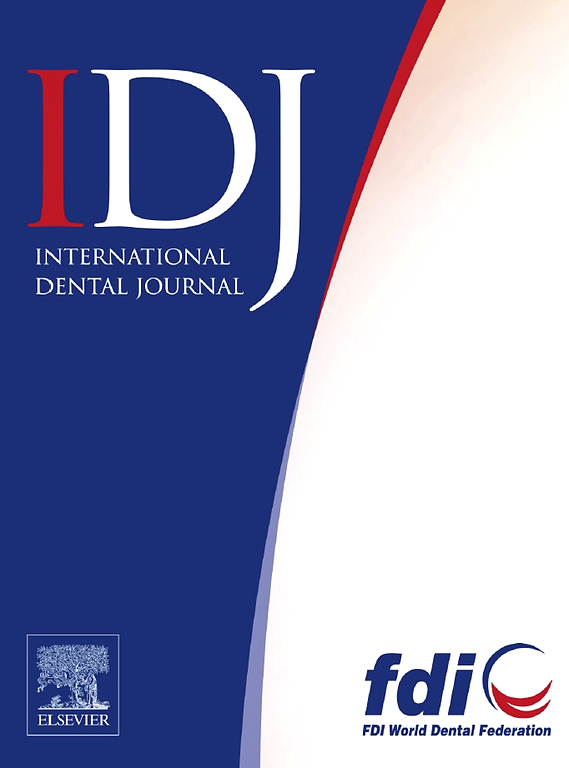Comparative Evaluation of Biocompatibility between Conventional and Computer-Aided Design/Computer-Aided Manufacturing Dental Polymers Using a Golden Hamster Model
IF 3.7
3区 医学
Q1 DENTISTRY, ORAL SURGERY & MEDICINE
引用次数: 0
Abstract
Introduction and aims
Computer-aided design/computer-aided manufacturing (CAD/CAM) dental polymers exhibit superior mechanical properties compared to conventional ones, but their biocompatibility remains controversial. This study aimed to systematically compare in vivo biocompatibility of conventional and CAD/CAM dental polymers using a golden hamster model.
Methods
Six dental polymers were evaluated: conventional (VAR) and CAD/CAM (OP) polymethylmethacrylate (PMMA) denture base materials; conventional bis-acrylic (PT) and CAD/CAM PMMA (DM) interim restorative materials; pressed (PB) and CAD/CAM (CB) polyetheretherketone (PEEK) prosthetic framework materials, with polypropylene as control. Disk specimens (n = 6) were sutured in golden hamster buccal pouches for 14- and 28-day mucosal irritation tests. Systemic and local biocompatibility was assessed through hepatic/renal function tests, histopathology (HE staining), apoptosis detection (TUNEL), and apoptosis-related molecular analysis (RT-qPCR and Western blot) of buccal pouch mucosa, liver, and kidney tissues.
Results
All groups showed normal physiological conditions throughout the study period. Histological examination revealed normal tissue morphology in all tested organs, with only mild or no mucosal irritation observed. Transient fluctuations were observed in ALB, A/G, BUN and TP at 14 days, but the differences between groups tended to stabilize at 28 days. The results of TUNEL and RT-qPCR demonstrated comparable results across all groups. The expression of Bax and Bcl-2 proteins in buccal pouch mucosa of VAR group were elevated at 28 days compared to 14 days, while only Bax protein was elevated in PB group (P < .05). The expression level of pro Caspase-3 protein in the liver tissue of VAR group and PT group decreased at 28 days (P < .05).
Conclusions
Both conventional and CAD/CAM dental polymers exhibited acceptable in vivo biocompatibility, but CAD/CAM dental polymers showed superior temporal stability.
Clinical Relevance
The superior temporal stability in the in vivo biocompatibility profile of CAD/CAM dental polymers supports their clinical preference for long-term prosthodontic applications.
用金仓鼠模型比较评价传统与计算机辅助设计/计算机辅助制造牙科聚合物的生物相容性。
简介与目的:计算机辅助设计/计算机辅助制造(CAD/CAM)牙科聚合物与传统聚合物相比具有优越的力学性能,但其生物相容性仍存在争议。本研究旨在利用金仓鼠模型系统比较传统和CAD/CAM牙用聚合物的体内生物相容性。方法:对六种牙科聚合物进行评价:常规(VAR)和CAD/CAM (OP)聚甲基丙烯酸甲酯(PMMA)义齿基托材料;常规双丙烯酸酯(PT)和CAD/CAM PMMA (DM)临时修复材料;压制(PB)和CAD/CAM (CB)聚醚醚酮(PEEK)假体框架材料,以聚丙烯为对照。将盘状标本(n = 6)缝合在金仓鼠颊囊中,进行14天和28天的粘膜刺激试验。通过肝/肾功能检查、组织病理学(HE染色)、细胞凋亡检测(TUNEL)和细胞凋亡相关分子分析(RT-qPCR和Western blot)对颊袋粘膜、肝脏和肾脏组织进行全身和局部生物相容性评估。结果:各组在整个研究期间均表现出正常的生理状态。组织学检查显示,所有被测器官的组织形态正常,仅观察到轻度或未观察到粘膜刺激。ALB、A/G、BUN和TP在第14天出现短暂波动,但在第28天组间差异趋于稳定。TUNEL和RT-qPCR的结果在所有组中都显示出可比性。VAR组颊袋黏膜Bax和Bcl-2蛋白表达在28 d较14 d升高,PB组仅Bax蛋白表达升高(P < 0.05)。VAR组和PT组肝组织中pro Caspase-3蛋白表达水平在28 d时降低(P < 0.05)。结论:传统牙科聚合物和CAD/CAM牙科聚合物均具有良好的体内生物相容性,但CAD/CAM牙科聚合物具有较好的时间稳定性。临床相关性:CAD/CAM牙科聚合物在体内生物相容性方面具有优越的时间稳定性,支持其长期修复应用的临床偏好。
本文章由计算机程序翻译,如有差异,请以英文原文为准。
求助全文
约1分钟内获得全文
求助全文
来源期刊

International dental journal
医学-牙科与口腔外科
CiteScore
4.80
自引率
6.10%
发文量
159
审稿时长
63 days
期刊介绍:
The International Dental Journal features peer-reviewed, scientific articles relevant to international oral health issues, as well as practical, informative articles aimed at clinicians.
 求助内容:
求助内容: 应助结果提醒方式:
应助结果提醒方式:


